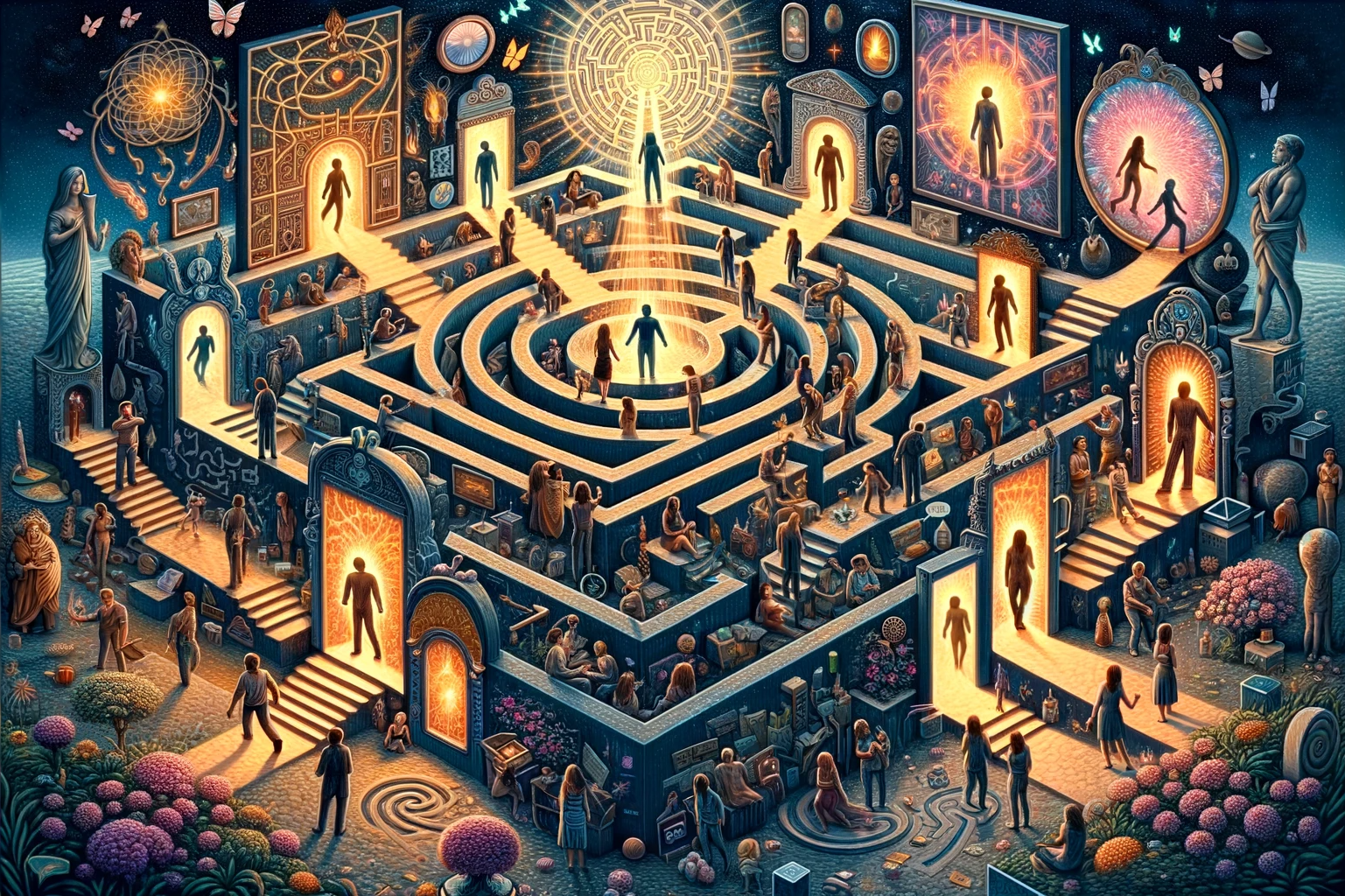Human relationships, in their myriad forms, are as complex as they are fascinating. Among the various puzzles they present, one particularly intriguing aspect is the tendency of some individuals to be attracted to those who treat them poorly. Conversely, these same individuals often build emotional walls against those who genuinely offer love and care. This paradoxical behaviour is not just a matter of personal choice or simple preference; it’s deeply rooted in the psychological makeup of an individual.
This article aims to delve into the psychological underpinnings of why some people find themselves repeatedly drawn to partners who are unkind, neglectful, or even abusive while simultaneously distancing themselves from potential partners who are supportive and loving. To understand this, we will explore various psychological theories and concepts, including attachment theory, self-esteem issues, the impact of past traumas, and the influence of societal and cultural factors.
Understanding this phenomenon is not only crucial for those who find themselves trapped in a cycle of unhealthy relationships but also for mental health professionals seeking to provide effective support and interventions. By exploring these complex psychological dynamics, we can begin to unravel the reasons behind these destructive attraction patterns and pave the way toward healthier, more fulfilling relationships.
Theories of Attraction and Attachment
The patterns of attraction and the nature of our relationships are deeply influenced by psychological theories and principles. Understanding these theories provides insight into why some individuals are drawn to those who treat them poorly while pushing away those who offer love and care.
1. Attachment Theory
Developed by John Bowlby and later expanded by Mary Ainsworth, Attachment Theory is central in understanding relationship patterns. It posits that the nature of our early attachments with primary caregivers forms the blueprint for future relationships. There are four main types of attachment styles:
- Secure Attachment: Individuals with a secure attachment had caregivers who were consistently responsive and supportive. They tend to have healthy, trusting relationships as adults.
Anxious-Preoccupied Attachment: These individuals had caregivers who were inconsistent in their responsiveness. As adults, they often feel insecure in relationships and may be clingy or overly dependent. - Dismissive-Avoidant Attachment: Often resulting from caregivers who were emotionally distant, these individuals tend to avoid close relationships, value their independence highly, and can seem emotionally distant.
- Fearful-Avoidant Attachment (Disorganized): Stemming from a background of trauma or severe inconsistency from caregivers, these individuals desire closeness but are fearful of getting hurt. They often have tumultuous relationships.
2. Repetition Compulsion
This concept, introduced by Sigmund Freud, suggests an unconscious drive to repeat patterns from one’s past, particularly unresolved traumas or conflicts. In the context of relationships, this can manifest as a pattern of being attracted to partners who resemble an aspect of past abusive or neglectful relationships. This repetition is an attempt, albeit misguided, to resolve past issues.
3. Self-Esteem and Self-Worth
The level of an individual’s self-esteem and self-worth can significantly influence their choice of partners. People with low self-esteem might subconsciously choose partners who treat them poorly because it aligns with their own negative self-view. They may feel undeserving of a partner who treats them with respect and love.
4. Cognitive-Behavioral Perspectives
Cognitive-behavioural Theories suggest that our thoughts and beliefs influence our feelings and behaviours. Negative thought patterns about oneself can lead to negative emotions, which then influence the choice of a partner. For instance, if someone believes they are unworthy of love, they may be more likely to accept poor treatment as they believe that’s all they deserve.
5. Evolutionary Psychology
From an evolutionary perspective, some argue that attraction to certain types of individuals may have been advantageous for survival in the past. For example, being attracted to a dominant or powerful partner, even if they are not kind, might have historically been seen as beneficial for protection or resource provision.
6. Sociocultural Influences
Finally, sociocultural factors play a significant role. Cultural narratives, media portrayals of relationships, and observed relationship dynamics in one’s community and family can all influence what one perceives as “normal” or desirable in a relationship, even if it is unhealthy.
Psychological Impact of Negative Relationships
Negative relationships, characterized by poor treatment, abuse, neglect, or emotional turmoil, have profound psychological impacts on individuals involved. These impacts can be far-reaching, affecting emotional well-being, mental health, and even physical health. In this detailed exploration, we’ll delve into the various psychological effects of being in negative relationships, drawing upon psychological theories and research findings.
1. Cognitive Dissonance and Rationalization
Cognitive dissonance occurs when an individual’s actions are in conflict with their beliefs or desires. In the context of negative relationships, a person might rationalize staying with a partner who treats them poorly. This mental discomfort leads to justifying or downplaying the negative behaviour of the partner. The individual might believe they deserve the treatment, or they might hold onto hope that the partner will change. This dissonance can create a cycle of justification, leading to prolonged exposure to the negative relationship.
2. Impact on Self-Esteem and Self-Worth
Continuous exposure to negative treatment in a relationship can lead to a significant decrease in self-esteem and self-worth. When individuals are constantly criticized, belittled, or made to feel unworthy, they may start to internalize these negative messages. This internalization can manifest in feelings of worthlessness, inadequacy, and a deep sense of failure. Low self-esteem makes it harder for individuals to leave unhealthy relationships, creating a vicious cycle.
3. Trauma Bonding
Trauma bonding refers to the strong emotional connection that develops between a victim and an abuser, particularly in relationships involving a cycle of abuse and kindness. This bond is paradoxical in nature – the kindness or affection shown sporadically by the abuser can seem more intense and meaningful against the backdrop of abuse, reinforcing the bond. Victims might misinterpret abuse as passion or deep emotional connection, making it challenging to leave the relationship.
4. Mental Health Consequences
Negative relationships can lead to various mental health issues. These include depression, anxiety, post-traumatic stress disorder (PTSD), and other stress-related disorders. The constant stress and emotional turmoil can trigger these conditions, and they may persist even after the relationship has ended. Individuals might experience symptoms like persistent sadness, anxiety, flashbacks, or nightmares.
5. Fear of Intimacy and Trust Issues
Experiencing a negative relationship can lead to a fear of intimacy and significant trust issues in future relationships. Having been hurt or betrayed, individuals may find it difficult to open up emotionally or trust others. They might avoid getting close to others or sabotage new relationships, fearing a repetition of past hurt.
6. Behavioural Changes and Coping Mechanisms
In response to the stress and trauma of a negative relationship, individuals might develop unhealthy coping mechanisms. These can include substance abuse, disordered eating, self-harm, or engaging in high-risk behaviours. These behaviours are often attempts to gain control, escape emotional pain, or cope with feelings of emptiness and loneliness.
7. Impact on Physical Health
The stress from negative relationships can also manifest physically. Chronic stress can lead to various health issues like hypertension, cardiovascular problems, weakened immune function, and gastrointestinal issues. The mind-body connection is strong, and prolonged emotional distress can have a tangible impact on physical health.
8. Isolation and Social Withdrawal
Victims of negative relationships often withdraw from friends, family, and social activities. This withdrawal can be due to shame, fear of judgment, or manipulation by the abusive partner. Isolation exacerbates the impact of the negative relationship, as the individual loses access to support systems and alternative perspectives.
9. Repetition of Unhealthy Patterns
Exposure to negative relationships, especially when they echo patterns from childhood or early life, can lead to a repetition of these unhealthy patterns. Individuals may find themselves repeatedly entering into similar kinds of relationships, perpetuating the cycle of negativity and abuse. This pattern often stems from unresolved issues and a subconscious drive to rectify past trauma.
10. Learned Helplessness
Learned helplessness is a state where a person feels powerless to change their situation due to repeated exposure to negative and uncontrollable circumstances. In the context of a negative relationship, this can result in a sense of resignation, where the individual believes they cannot escape or change their situation. This belief can make them more susceptible to staying in harmful relationships.
11. Identity and Sense of Self
Long-term negative relationships can erode an individual’s sense of self. Their identity might become enmeshed with the relationship, and they may lose sight of their own needs, desires, and aspirations. Recovering one’s sense of individual identity after such relationships can be a lengthy and challenging process.
12. Resilience and Growth
While negative relationships have numerous detrimental effects, some individuals experience post-traumatic growth following these experiences. This growth can involve developing greater resilience, a deeper understanding of self, improved coping skills, and a renewed appreciation for healthy relationships. It’s important to recognize that while growth is possible, it often requires substantial support, self-reflection, and sometimes professional help.

 Overcoming Unhealthy Attraction Patterns
Overcoming Unhealthy Attraction Patterns
